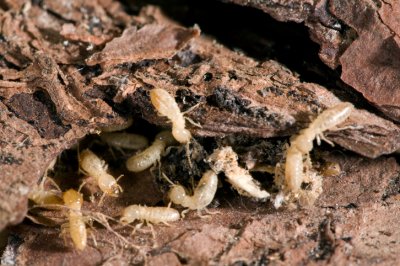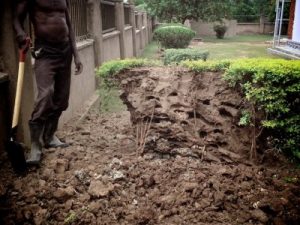 Mulch and termites. There definately is a connection between these two, however it’s not that obvious some people might think. Termites can potentially cause thousands of dollars damage with pest company services being very expensive aswell.
Mulch and termites. There definately is a connection between these two, however it’s not that obvious some people might think. Termites can potentially cause thousands of dollars damage with pest company services being very expensive aswell.
If you use wood mulch or any other kind of mulch, you need to know why termites get attracted to ground covered with mulch and how to control them.
Here we will describe how they actually interfere, what are the risk and how can you deal with it without giving up a mulch.
Hide content
- Does mulch actually attract termites?
- Does the type of mulch even matter?
- How can you detect termites in a mulch?
- How to deal with termites in a mulch?
- Useful articles
- Conclusion
Does mulch actually attract termites?
You see, the essential living condition for all the termites is the moisture. Without it they just dehydrate and die. Any kind of mulch (even the gravel one) provides covering to a soil making it moist, which surely attract subterranian termites, especially if you have trees and wooden structures nearby (or your neighbor does).
What you should really bother with, is the subterranian termites attracted by the moisture provided by mulch. For they will barely feed on mulch, but search for more nutritious food sources in proximity like your house, trees or any wooden structure.If you dont have anything like that nearby, you shouldnt care of them at all. But if you do, you’d better read further unless you are okay with thousands of dollars damages due to termite activity (not saying about a damaged tree accidentaly falling on your head or damaging your neighbor’s structures).
Learn more about drywood termites: signs of their activity; best methods of treatment: spot treatment and DIY methods; how to get rid of them in furniture?
Does the type of mulch even matter?
Termites eat only dead wood in most cases. Now, the thing is, any wood mulch is very low on nutrition for termites. They CAN actually feed on it, but they wont last long that way – 10 to 14 weeks max, according to studies.
Wood mulch is never going to be a reliable source of food for termites.
Even if you find termites in a bag of mulch you have just brought from the local shop, you can be sure they wont last long (even though they survived the wood shredding) and you shouldnt bother with this.
The some kind of wood mulch more attractive to subterranian termites comparing to other types of mulch. However, these insects still wont last longer than 14 weeks feeding on pine mulch only.So the type of wood doesnt really matter here, for termites will unlikely feed on any mulch itself, but search for attractive food sources nearby. There are kinds of wood which can be resistant or even toxic to termites.
Termite-favoured types of mulch:
- cypress sapwood;
- loblolly pine;
- slash pine;
- bark mulch.
Termite-resistant types of wood mulch:
- cypress heartwood;
- melaleuca;
- eucalyptus;
- southern tidewater red cypress;
- California redwood as termite-resistant mulch.
Termite-repellent types of mulch:
- cypress heartwood;
- cedar;
- any boric acid treated mulch.
Here you can learn more information about effective termite control remedies: Boric acid, Borate, Chlorpyrifos, Chlordane, Borax, Timbor, Terminator, Lorsban, Biflex, Terro.
How can you detect termites in a mulch?
Aside from spotting the flying termite swarm around your house or a yard, you can observe the tiny tunels and galleries of mud termites do to ensure safe passages inside the wooden structure.
You might spot tiny holes with sometimes wooden dust nearby in the piences of mulch or any wood nearby.
You can also dig up the mulch you might put right near your house or any structure and sometimes you may find not only termites in that soild, but the whole colony with eggs and whatnot.
How to deal with termites in a mulch?
First of all, make sure you apply your mulch in 2-3 inches thick layer with no direct contact with any wooden structures (i.e. your house).
The best option would be making a buffer zone betwen the mulch and your house by leaving at least a 30 cm long strip of bare dirt. Try to keep it dry so this ground will be uncomfortable for termites. Mulch inself should also be kept dry, so rake it from time to time.
WARNING: do not overwater your mulch as it does not only attract termites, but also makes harm to the plants growing there.Learn more about subterranean termites: signs of their activity; best methods of treatment and DIY methods. Eastern subterranean termites and their tunnels and tubes with photo.
You can also apply liquid termiticide soil treatment with fipronil-based being the best option (make sure to check the certain termiticide safety conditions, like no water bodies or cultivated food sites in proximity). The liquid soil treatment can be applied to the ground covered with mulch, though you can apply it to the buffer zone only with great effect, if the toxicity is concern.
You also do not need any pest companies to do so, if you read the label’s instructuions and and check guids on making termiticide soil treatments yourself. Fipronil-based termiticides are the best option here because they can be spread by termites all over the colony, which will eliminate the whole population with time.
The mulch itself can also be treated by termiticides aswell. You can even buy a mulch treated with boric acid from the store. Boric acid is a natural termiticide with low toxicity, often used for wood treatment. It will kill all the termites trying to feed on mulch.
More information about How to Fight Termites in Mulch?
Down below there is a brief info on the most popular and effective liquid soil treatment termiticides.
Liquid termiticides can be either repellent or non-repellent.
The repellent termiticides are designed to repel termites away from structures and have a specific usage – mostly in preconstriction treatment (before the structure is built) and for fast control of subterranian termites.
The main problem with repellent termiticids is that there shouldnt be any gaps untreated, for termites can exploit them sooner or later.
- Talstar Professional (Bifenthin) – very low cost, reliable, effective, has been applied for years;
- Bifen Insecticide / Termiticide (Generic Bifenthrin) – a lower cost analogue;
- Dragnet FT (Permethrin) – highly toxic and repellent to subterranean termites;
- Prelude (Permethrin) – is a low odor analogue, relatively short living termite control product thus does not cause a long lasting soil contamination.
The non-repellent termiticides do not repel, but stick to termites, intoxicating them one by one and eventually killing the whole population over time. This type is useful for controling large areas and is often used for house protection.
- Termidor (Fipronyl) – the most popular termite control product in USA and Australia, widely used by many pest control companies. Considered the most effective termiticide and used by a lot of pest control companies.
- Taurus – (Fipronyl) a cheaper analogue.
- Altriset – (Chlorantraniliprole) eco-friendly product, but a bit less effective. it is the best option, when environmental safety in a major concern.
- Premise 2 / Premise 75 (Imidichloprid) – the most popular one in most countries. The main chemical component is derived from tobacco leaves, it causes termites to die in large quantities in the same place. That frightens other termites and banishes them naturaly.
- I MaxxPro 2F / I MaxxPro WP (Imidichloprid) – a cheaper analogue.
- Phantom – (Chlofenapyr) – very popular one, absolutely undetectable by termites, so it can be applied to few spots in small quantities, which makes it economical.
- Bora Care – (Sodium Borate) – a special wood treatment chemical, which will last the life of the wood when applied.
Termite baits can help you to deal with termites aswell, if you dont want to apply termiticide soil treatment for some reason. They cost more and are less effective actually, though they do not make the soil toxic.
Install these baits into the ground, put some wood there and check them from time to time. Once you have found the tracks of termite activity inside or nearby, you apply boric acid or any preferable termiticide to these baits.Here you can learn more information about termite bait systems: Advance, Green, CSIRO, Nemesis, Exterra, Firstline, Terminate. Also find out how to make baits by yourself and how to refill them?
Useful articles
If you interested in more information of termites we recommend you to read the following articles:
- All types of termites. Are they harmful to humans? Can they bite you? And what is the difference between drywood and subterranean ones?
- What does swarmers of different species look like: drywood, subterranean, formosan?
- Signs of infestation outside and in the house: in walls or furniture.
- What does termite holes look like? What is droppings and is it toxic to humans? Do termites make noises?
- Posible termite damage, how does it look like? Examples of damage in walls and wood floors.
- All about flying termites: how do they look like, swarming season and what to do if there are swarmers in your house?
- How do they do nests and mounds? How to find it in your garden or inside the house?
- Termite life cycle – from egg to larvae. And social hierarchy: workers, soldiers, queen.
- Did you know that termites can infest living trees, for example a palm or a pine tree. They also like to live in stumps.
- You can prevent the infestation by using barriers, such as: HomeGuard, Physical systems, Safeguard, Stainless steel mesh, Kordon.
Conclusion
Keep an eye on your yard and house for signs of termite activity, especially during spring, when termites are most active, because termites can cause thousands of dollars damage, so you’d have to apply all the measures rapidly.
Applying any termite treatment costs some significant amount of money aswell, so to avoid unpredictable expenses, for instance, right before your vacation, you’d better apply all the measures necessary beforehand, for in this case prevention is better than cure.
